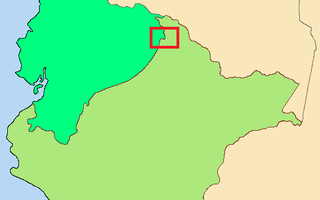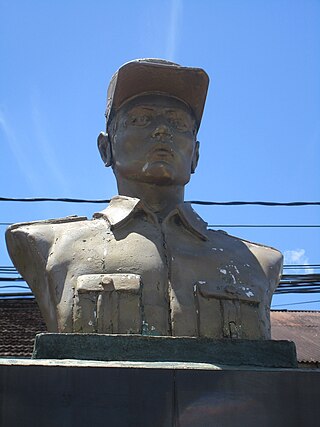
The Pastaza River also known as the Patate, flowing in Ecuador and Peru is a large tributary to the Marañón River in the northwestern Amazon Basin of South America.

The Cenepa War or Third Ecuadorian-Peruvian War, also known as the Alto Cenepa War, was a brief and localized military conflict between Ecuador and Peru, fought over control of an area in Peruvian territory near the border between the two countries. The two nations had signed a border treaty following the Ecuadorian–Peruvian War of 1941, but Ecuador later disagreed with the treaty as it applied to the Cenepa and Paquisha areas, and in 1960 it declared the treaty null and void. Most of the fighting took place around the headwaters of the Cenepa River.

The Argentine War of Independence was a secessionist civil war fought from 1810 to 1818 by Argentine patriotic forces under Manuel Belgrano, Juan José Castelli, Martin Miguel de Guemes and José de San Martín against royalist forces loyal to the Spanish crown. On July 9, 1816, an assembly met in San Miguel de Tucumán, declaring independence with provisions for a national constitution.

Sucumbíos is a province in northeast Ecuador. The capital and largest city is Nueva Loja. It is the fifth largest province in the country, with an area of 18,084 km2. In 2010, it had a population of 176,472 inhabitants.

The Ecuadorian–Peruvian War, known locally as the War of the '41, was a South American border war fought between 5–31 July 1941. It was the first of three military conflicts between Ecuador and Peru during the 20th century.

The Aguarico River is a river in northeastern Ecuador. It is the main river of the Sucumbíos province. In the last part of its course it marks the Ecuadorian-Peruvian border. It empties into the Napo River. It has a length of 390 km (240 mi), of which the last 50 km (31 mi) extend along the natural border between Ecuador and Peru. The lower course of the Aguarico River was finalized and legally demarcated as part of the long-disputed Ecuador-Peru frontier according to The Rio de Janeiro Protocol of 1942. Ecuador unilaterally denounced the protocol in 1960, however a new agreement was signed in 1999, validating the pre-existing protocol.

The Ecuadorian–Peruvian territorial dispute was a territorial dispute between Ecuador and Peru, which, until 1928, also included Colombia. The dispute had its origins on each country's interpretation of what Real Cedulas Spain used to precisely define its colonial territories in the Americas. After independence, all of Spain's colonial territories signed and agreed to proclaim their limits in the basis of the principle of uti possidetis juris, which regarded the Spanish borders of 1810 as the borders of the new republics. However, conflicting claims and disagreements between the newly formed countries eventually escalated to the point of armed conflicts on several occasions.

The Ecuadorian Army is the land component of the Ecuadorian Armed Forces. Its 25,650 active soldiers are deployed in relation to its military doctrine. The contemporary Ecuadorian Army incorporates many jungle and special forces infantry units into its structure.
The Secoya are an indigenous peoples living in the Ecuadorian and Peruvian Amazon. They speak the Secoya language Pai Coca, which is part of the Western Tucanoan language group. In Ecuador the Secoya number about 400 people who for the most part are located in three settlements, Eno, San Pablo de Katitsiaya and Siecoya Remolino, all found on the banks of the Aguarico river. Their Ecuadorian territory covers 40.000 hectares along the Shushufindi, Aguarico, and Cuyabeno river in the state of Sucumbios. Until recently they shared territory with the Siona people, with whom they are sometimes considered a single population, although both peoples have independent governance. In Peru the Secoya population numbers about 700.

The Oriente is a region of eastern Ecuador, comprising the eastern slopes of the Ecuadorian Andes and the lowland areas of rainforest in the Amazon basin.

The Battle of Tarqui, also known as the Battle of Portete de Tarqui, took place on 27 February 1829 at Tarqui, near Cuenca, today part of Ecuador. It was fought between troops from Gran Colombia, commanded by Antonio José de Sucre, and Peruvian troops under José de La Mar. Although the Colombian troops achieved victory over the Peruvian vanguard, destroying it and forcing the rest of their forces to withdraw, they suffered heavy losses in their cavalry with the Peruvian charge, which made it difficult to continue the campaign and caused the stabilization of the front.

Aguarico Canton is a canton of Ecuador, located in the Orellana Province. Its capital is the town of Nuevo Rocafuerte. Its population at the 2010 census was 4,658 INEC 2010.

Rosa Panduro District is a district of the Putumayo Province in Peru, and one of the four districts that comprise that province.

The Battle of Zarumilla or Zarumilla offensive was a military confrontation between Peru and Ecuador that took place from July 23 to 31 during the 1941 Ecuadorian–Peruvian War.

The Battle of Pantoja and Rocafuerte, known also simply as the Battle of Rocafuerte, was a military confrontation between Peru and Ecuador that took place on August 11, 1941, during the Ecuadorian–Peruvian War.

Cabo Pantoja, formerly Rocafuerte and Pantoja, is a town in the Torres Causana District of the Loreto Department in Peru.

Víctor F. Pantoja y Castillo was a Peruvian corporal killed in action in 1904 during the Ecuadorian–Peruvian territorial dispute.

Carmen Rosa Panduro Ramírez was a Peruvian housewife who fought against Ecuadorian troops in the Battle of Rocafuerte during the 1941 Ecuadorian–Peruvian War.

The Peruvian occupation of Ecuador was the military occupation by the Peruvian Army of the southern provinces of Ecuador that lasted from 1941 to 1942, during the Ecuadorian–Peruvian War. After a ceasefire was declared on July 31, 1941, the civil administration became limited to the provinces of El Oro and Loja until the Rio Protocol was signed on January 29, 1942, with Peruvian troops withdrawing on February 12.

Alfredo Medardo Novoa Cava was a Peruvian captain who was killed in action during the 1941 Ecuadorian–Peruvian War.



















